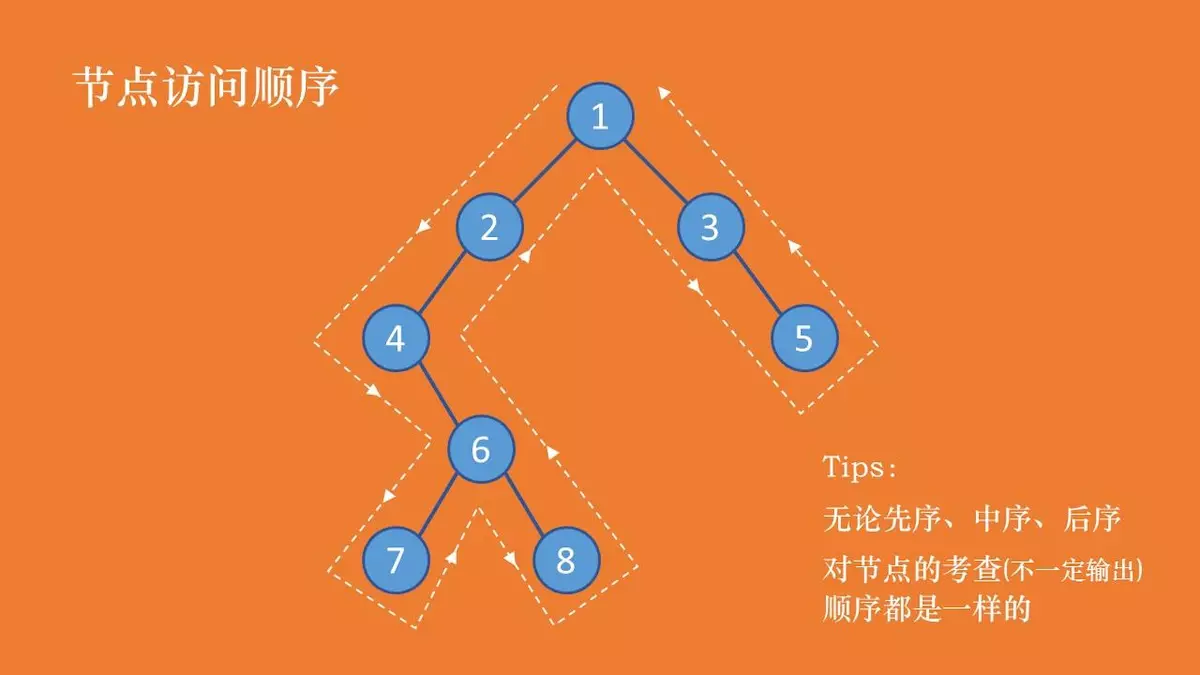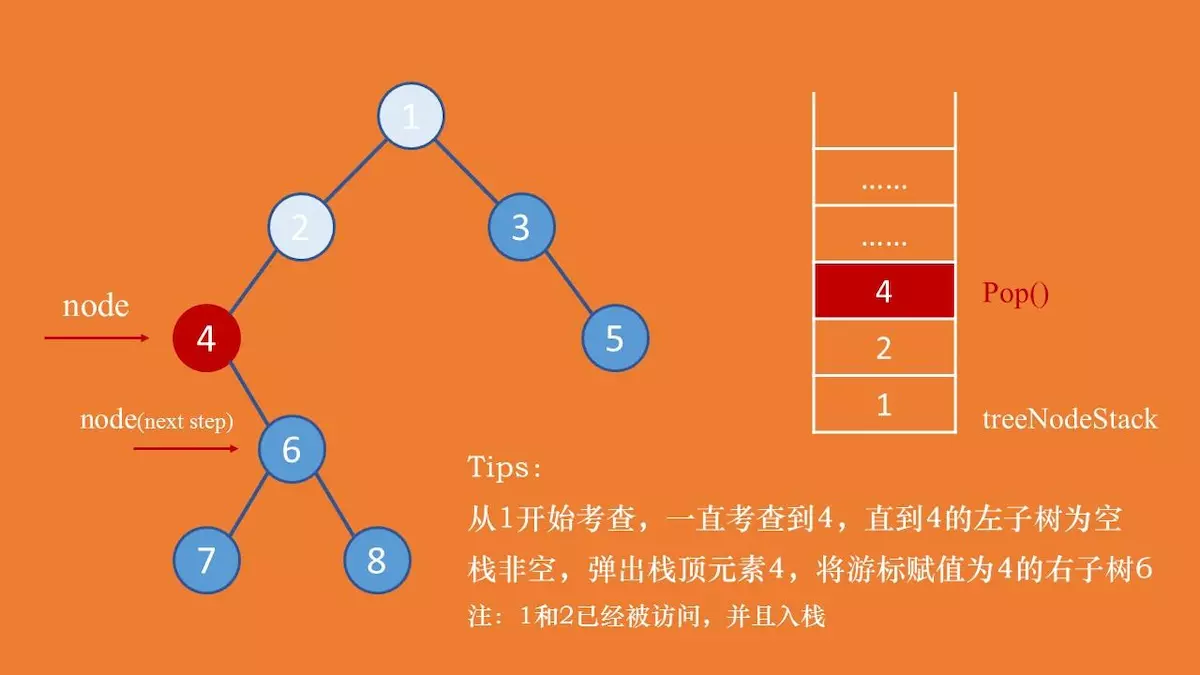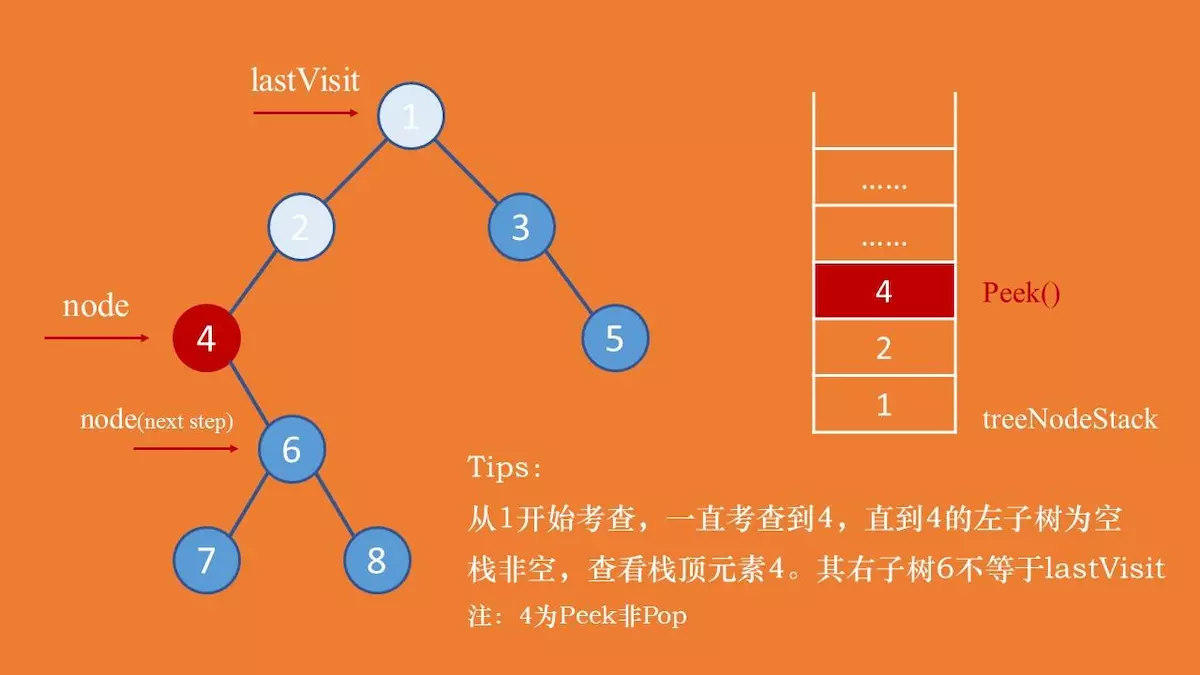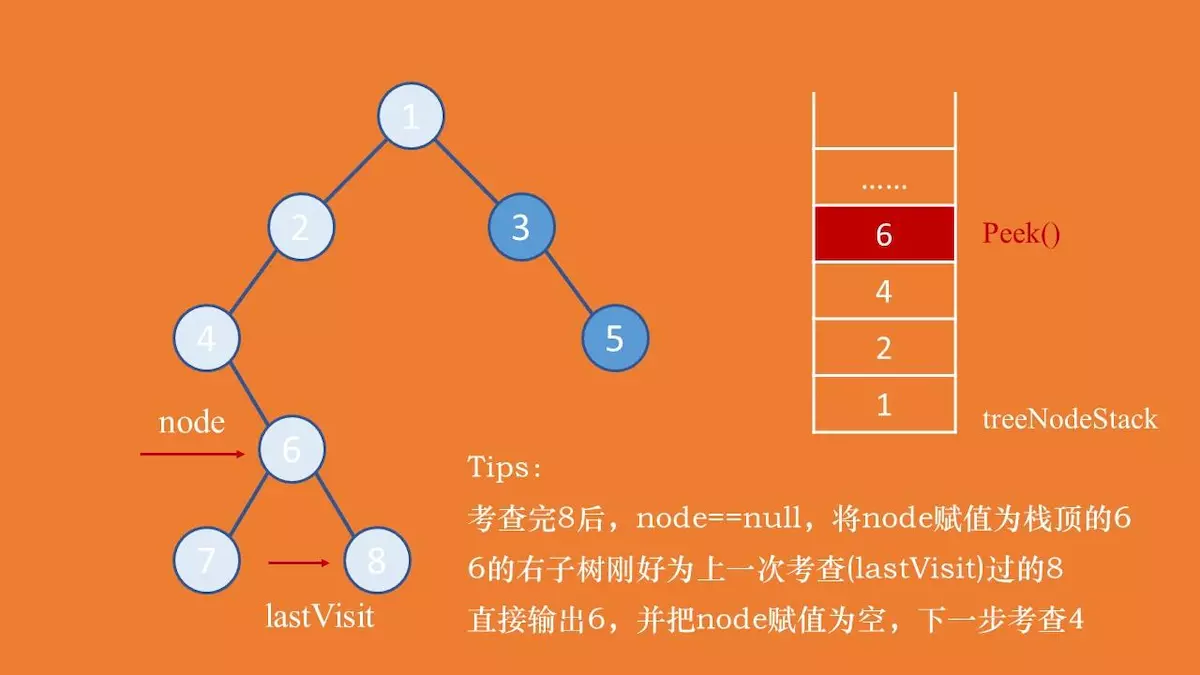无论是哪种遍历方法,考查节点的顺序都是一样的(思考做试卷的时候,人工遍历考查顺序)。只不过有时候考查了节点,将其暂存,需要之后的过程中输出。

先序:1 2 4 6 7 8 3 5 中序:4 7 6 8 2 1 3 5 后序:7 8 6 4 2 5 3 1
三种遍历方法的考查顺序一致,得到的结果却不一样,原因在于: **先序:**考察到一个节点后,即刻输出该节点的值,并继续遍历其左右子树。(根左右) **中序:**考察到一个节点后,将其暂存,遍历完左子树后,再输出该节点的值,然后遍历右子树。(左根右) **后序:**考察到一个节点后,将其暂存,遍历完左右子树后,再输出该节点的值。(左右根)
下面展示了使用统一迭代写法写出三种遍历:

/**
* Definition for a binary tree node.
* public class TreeNode {
* int val;
* TreeNode left;
* TreeNode right;
* TreeNode() {}
* TreeNode(int val) { this.val = val; }
* TreeNode(int val, TreeNode left, TreeNode right) {
* this.val = val;
* this.left = left;
* this.right = right;
* }
* }
*/
class Solution {
public List<Integer> preorderTraversal(TreeNode root) {
List<Integer> path = new ArrayList<>();
Stack<TreeNode> stack = new Stack<>();
TreeNode p = root;
while (p != null || !stack.empty()) {
// 访问该节点并加到 path 中(前序先访问根节点),同时继续访问该节点的左子树
// 等到访问到叶子节点时,栈顶元素即该叶子节点
while (p != null) {
path.add(p.val);
stack.push(p);
p = p.left;
}
// 从栈中弹出一个节点,即拿到当前访问节点的父节点,然后把当前节点 p 置为右子树
// 注意:上面的 while 实际上访问到叶子节点的时候已经访问了一个 leaf 节点了,
// 即已经访问了 根 -> 左,接下来只需要访问右子树了
if (!stack.empty()) {
TreeNode tmp = stack.pop();
p = tmp.right;
}
}
return path;
}
}另一种写法,从根节点开始,每次迭代弹出当前栈顶元素,并将其孩子节点压入栈中,先压右孩子再压左孩子。 在这个算法中,输出到最终结果的顺序按照 Top->Bottom 和 Left->Right,符合前序遍历的顺序。
Tips: 该写法也适用于 N 叉树的前序遍历
class Solution {
public List<Integer> preorderTraversal(TreeNode root) {
LinkedList<TreeNode> stack = new LinkedList<>();
LinkedList<Integer> output = new LinkedList<>();
if (root == null) {
return output;
}
stack.add(root);
while (!stack.isEmpty()) {
TreeNode node = stack.pollLast();
output.add(node.val);
// 让左子树在栈顶,这样就可以先被遍历到
if (node.right != null) {
stack.add(node.right);
}
if (node.left != null) {
stack.add(node.left);
}
}
return output;
}
}/**
* Definition for a binary tree node.
* public class TreeNode {
* int val;
* TreeNode left;
* TreeNode right;
* TreeNode() {}
* TreeNode(int val) { this.val = val; }
* TreeNode(int val, TreeNode left, TreeNode right) {
* this.val = val;
* this.left = left;
* this.right = right;
* }
* }
*/
class Solution {
public List<Integer> inorderTraversal(TreeNode root) {
List<Integer> path = new ArrayList<>();
Stack<TreeNode> stack = new Stack<>();
TreeNode p = root;
while (p != null || !stack.empty()) {
// 先一直访问左子树,不加到 path 中(中序需要先访问左子树才访问根节点)
// 等到访问到叶子节点的时候,stack 上栈顶的元素即该叶子节点
while (p != null) {
stack.push(p);
p = p.left;
}
if (!stack.empty()) {
TreeNode tmp = stack.pop();
path.add(tmp.val);
p = tmp.right;
}
}
return path;
}
}后续遍历和先序、中序遍历不太一样。后序遍历在决定是否可以输出当前节点的值的时候,需要考虑其左右子树是否都已经遍历完成。所以需要设置一个 lastVisit 游标。
若 lastVisit 等于当前考查节点的右子树,表示该节点的左右子树都已经遍历完成,则可以输出当前节点。 并把 lastVisit 节点设置成当前节点,将当前游标节点 node 设置为空,下一轮就可以访问栈顶元素。否者,需要接着考虑右子树,node = node.right。
以下考虑后序遍历中的三种情况:



/**
* Definition for a binary tree node.
* public class TreeNode {
* int val;
* TreeNode left;
* TreeNode right;
* TreeNode() {}
* TreeNode(int val) { this.val = val; }
* TreeNode(int val, TreeNode left, TreeNode right) {
* this.val = val;
* this.left = left;
* this.right = right;
* }
* }
*/
class Solution {
public List<Integer> postorderTraversal(TreeNode root) {
List<Integer> path = new ArrayList<>();
TreeNode lastVisit = root;
TreeNode p = root;
Stack<TreeNode> stack = new Stack<>();
while (p != null || !stack.empty()) {
while (p != null) {
stack.push(p);
p = p.left;
}
if (!stack.empty()) {
TreeNode cur = stack.peek();
if (lastVisit == cur.right || cur.right == null) {
stack.pop();
path.add(cur.val);
lastVisit = cur;
} else {
p = cur.right;
}
}
}
return path;
}
}参考前序遍历的写法,前序遍历的顺序是 root -> left -> right,后序遍历的顺序是 left -> right -> root,把后序遍历序列 reverse 后,顺序为 root -> right -> left,其与前序遍历序列的区别在于前序遍历序列是先 left 后 right,而该序列是先 right 后 left。
class Solution {
public List<Integer> postorderTraversal(TreeNode root) {
LinkedList<TreeNode> stack = new LinkedList<>();
LinkedList<Integer> ret = new LinkedList<>();
if (root == null) return ret;
stack.add(root);
while (!stack.isEmpty()) {
TreeNode node = stack.pollLast();
// 每次加到开头,或者和前序遍历序列一样加到结尾,然后最后的结果reverse
ret.addFirst(node.val);
// 遍历的顺序是先right后left,入栈的顺序相反
if (node.left != null) stack.add(node.left);
if (node.right != null) stack.add(node.right);
}
return ret;
}
}- https://leetcode-cn.com/problems/binary-tree-preorder-tra versal/solution/dai-ma-sui-xiang-lu-chi-tou-qian-zhong-hou-xu-de-d/
- https://leetcode-cn.com/problems/binary-tree-preorder-traversal/solution/pythongai-bian-yi-xing-dai-ma-shi-xian-er-cha-shu-/
我们以中序遍历为例,之前说使用栈的话,无法同时解决处理过程和访问过程不一致的情况,那我们就将访问的节点放入栈中,把要处理的节点也放入栈中但是要做标记,标记就是要处理的节点放入栈之后,紧接着放入一个空指针作为标记。
以树[1, 2, 3, 4, 5, 6] 为例:
- 初始root入栈: [1]
- 弹出 1 并入栈得到: [3, 1, null, 2]
- 弹出 2 并入栈得到: [3, 1, null, 5, 2, null, 4]
- 弹出 4 并入栈得到: [3, 1, null, 5, 2, null, 4, null]
- 弹出 null 并弹出 4 输出结果得到: [3, 1, null, 5, 2, null], ret = [4]
- 弹出 null 并弹出 2 输出结果得到: [3, 1, null, 5], ret = [4, 2]
- 弹出 5 并入栈得到: [3, 1, null, 5, null]
- 弹出 null 并弹出 5 输出结果得到: [3, 1, null], ret = [4, 2, 5]
- 弹出 null 并弹出 1 输出结果得到: [3], ret = [4, 2, 5, 1]
- 弹出 3 并入栈得到: [3, null, 6]
- 弹出 6 并入栈得到: [3, null, 6, null]
- 弹出 null 并弹出 6 输出结果: [3, null], ret = [4, 2, 5, 1, 6]
- 弹出 null 并弹出 3 输出结果: [], ret = [4, 2, 5, 1, 6, 3]
class Solution {
public List<Integer> inorderTraversal(TreeNode root) {
Stack<TreeNode> stack = new Stack<>();
List<Integer> ret = new ArrayList<>();
if (root != null) stack.push(root);
while (!stack.isEmpty()) {
TreeNode node = stack.pop();
if (node != null) {
if (node.right != null) stack.push(node.right);
// 把root入栈并加入null标记下次该节点应该output
stack.push(node);
stack.push(null);
if (node.left != null) stack.push(node.left);
} else {
node = stack.pop();
ret.add(node.val);
}
}
return ret;
}
}class Solution {
public List<Integer> postorderTraversal(TreeNode root) {
Stack<TreeNode> stack = new Stack<>();
List<Integer> ret = new ArrayList<>();
if (root != null) stack.push(root);
while (!stack.isEmpty()) {
TreeNode node = stack.pop();
if (node != null) {
if (node.right != null) stack.push(node.right);
if (node.left != null) stack.push(node.left);
stack.push(node);
stack.push(null);
} else {
node = stack.pop();
ret.add(node.val);
}
}
return ret;
}
}class Solution {
public List<Integer> postorderTraversal(TreeNode root) {
Stack<TreeNode> stack = new Stack<>();
List<Integer> ret = new ArrayList<>();
if (root != null) stack.push(root);
while (!stack.isEmpty()) {
TreeNode node = stack.pop();
if (node != null) {
stack.push(node);
stack.push(null);
if (node.right != null) stack.push(node.right);
if (node.left != null) stack.push(node.left);
} else {
node = stack.pop();
ret.add(node.val);
}
}
return ret;
}
}